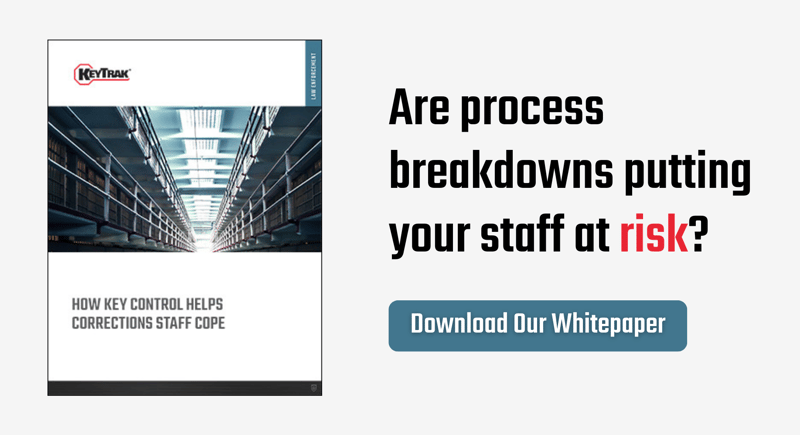"It should not be that easy to grab keys and take off." These are words no one wants to hear in relation to a prison. But that’s exactly what a representative for a Washington correctional facility said following an inmate’s escape. During routine maintenance, the prisoner entered an office and removed a staff member’s car keys, allowing him to escape.
To prevent costly security failures such as these, prisons must implement strict key management systems. Let’s examine why key control is important and how to implement effective key control in your correctional facility.
The Cost of Inadequate Key Control
The consequences of poor key management are far-reaching, leading to serious consequences that affect multiple aspects of facility operations.
Safety Risks
When an inmate gains access to keys, they jeopardize prison staff and other inmates. In high-stress situations, when every second counts, the consequences of inadequate key management can escalate quickly, leading to significant security risks.
Security Inspection Deficiencies
Key control is a critical component of compliance audits. Any deficiencies in your key management process could result in citations or penalties during state inspections. If your state’s guidelines are based on standards from the National Institute of Corrections or American Correctional Association standards, your facility is required to have a comprehensive key control plan.
Rekeying Costs
Lost or stolen keys lead to significant rekeying costs. For instance, over the past decade, the UK government has spent £2 million (approximately $2.6 million) replacing prison locks on 10 separate occasions after keys were lost or stolen, including a situation where a staff member took an entire set of keys.
In the U.S., average rekeying costs for prison locks range from $50 to $1,000 per lock:
- Mechanical Locks: $50–$200
- Electronic Locks: $150–$500
- Biometric Locks: $300–$1,000
These costs can quickly escalate, especially if lost or stolen keys require complete lock replacement across entire wings or facilities.
Lack of Staff Accountability
Without proper checks and balances, it’s easier for staff to misuse keys, whether intentionally or not. For instance, the high levels of stress among correctional officers can lead to mistakes in key management, increasing the risk of unauthorized access and compromising facility security.
Understanding these consequences is crucial not just for the safety of staff and inmates but also for protecting your facility’s budget. Mitigating the risks associated with inadequate key control can help ensure smoother operations and a safer environment for everyone.
Implementing Effective Prison Key Control
Implementing an electronic key management system addresses these challenges by securing keys, controlling who can access them, and maintaining a verifiable key log. When considering upgrading to key control, look for the following features:
Total Lockdown Capabilities
When keys are stored in traditional cabinets or on pegboards, there's no way to restrict how many keys an employee can remove, creating opportunities for security breaches. For the highest level of security, consider a key management system that locks keys down with individual solid steel lock cylinders, designed with enough space to accommodate Folger Adam keys. The system will only release these keys to authorized users, preventing tampering and theft. Such systems should also be kept in central locations that allow authorized staff to access keys quickly yet securely.

KeyTrak Guardian system with total lockdown key panels
Automatic Audit Trail
Manual methods like handwritten logbooks and pegboards create significant security vulnerabilities if someone neglects to update — or even intentionally falsifies — data. An electronic system creates an automatic, tamper-proof audit trail that records information about who checked out a key and when via user-specific login credentials, such as a fingerprint scan. This creates a more safe and organized facility while also enforcing employee accountability.
Automated Alerts and Monitoring
Manual key control provides no way to track overdue keys or unauthorized access attempts. By the time you discover a missing key during physical inventory, the security breach has already occurred.
Electronic key control systems offer:
- Instant alerts for overdue keys or unauthorized access attempts
- Automated reports
- Remote system management
With these features, you’ll be able to quickly respond to potential security breaches.
Access Levels
Having a system that automatically enforces access levels allows you to control which keys are available to staff members based on their job functions, time of day, or even days of the week. This capability prevents staff members from accessing areas of the facility or assets they don’t need access to. For instance, correctional officers may have access to keys for common areas and inmate housing units during their shifts, while maintenance staff might only have access to keys for areas requiring repairs during designated hours.
Implementing electronic key management system isn’t just a best practice — it’s an essential step to protect your facility and staff and prevent costly security failures. With effective key control practices, you can ensure both your keys and your facility remain secure.


